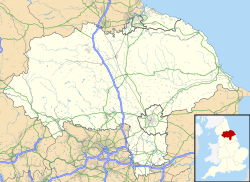| RAF Marston Moor RAF Tockwith | |||||||||||
|---|---|---|---|---|---|---|---|---|---|---|---|
| Tockwith, North Yorkshire in England | |||||||||||
 | |||||||||||
| Site information | |||||||||||
| Type | Royal Air Force station 41 Base HQ 1943-44 74 Base HQ 1944-45 | ||||||||||
| Code | MA [1] | ||||||||||
| Owner | Air Ministry | ||||||||||
| Operator | Royal Air Force | ||||||||||
| Controlled by | RAF Bomber Command * No. 4 Group RAF * No. 7 (T) Group RAF | ||||||||||
| Location | |||||||||||
| Coordinates | 53°57′42″N001°18′16″W / 53.96167°N 1.30444°W | ||||||||||
| Site history | |||||||||||
| Built | 1940/41 | ||||||||||
| Built by | John Laing & Son Ltd | ||||||||||
| In use | 1941–1949 | ||||||||||
| Garrison information | |||||||||||
| Past commanders | Group Captain Leonard Cheshire | ||||||||||
| Airfield information | |||||||||||
| Elevation | 21 metres (69 ft) [1] AMSL | ||||||||||
| |||||||||||
Royal Air Force Marston Moor or more simply RAF Marston Moor is a former Royal Air Force station located near Tockwith, North Yorkshire, England. It was operational during the Second World War and was originally called RAF Tockwith, but confusion with RAF Topcliffe led to the name change. [2] [3]
Contents
RAF Marston Moor was opened on 11 November 1941, [4] the airfield and RAF Church Fenton were the closest airfields to West Yorkshire and would act as a defence should Leeds be attacked. As it happens Leeds was seldom bombed.
In 1943, Group Captain Leonard Cheshire was made the station commander. He requested to be transferred to the command of 617 Squadron in November 1943, a vacancy created by the loss of George Holden in July of that year. The move required him to voluntarily step down in rank from group captain to wing commander, which he did.
Marston Moor was also in control of RAF Rufforth and RAF Riccall. [2]

